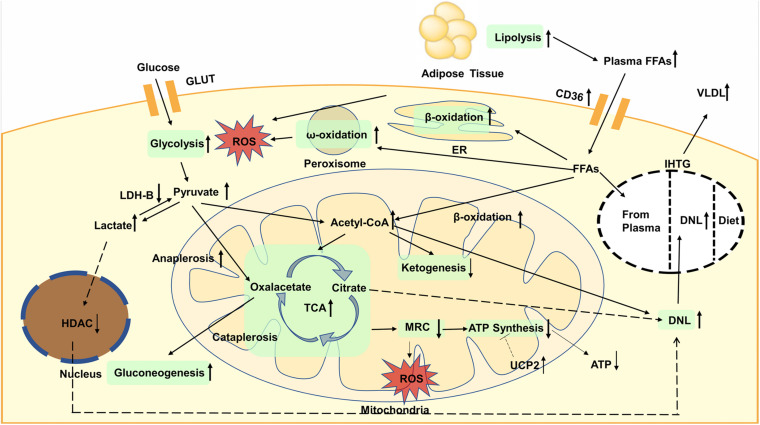FIGURE 1.
Glycolysis is enhanced, resulting in the increased content of pyruvate in plasma and liver. Then pyruvate is converted to oxaloacetate through anaplerosis or to lactate, both of which are enhanced in NAFLD. Increased lactate will elevate the expression of lipogenic enzymes dependent on decreased activity of nuclear HDAC. Gluconeogenesis is increased and contribute to TCA cycle. Lipolysis is increased, leading to elevated plasma FFAs. accumulation of TAGs is mainly caused by increased DNL. The oxidation of fatty acids is also enhanced, not only in the mitochondria, but also in the endoplasmic reticulum and peroxisomes. The oxidation that occurs in the latter can lead to more production of ROS that causes inflammation and liver damage. Increased glycolysis and fatty acid oxidation will elevate acetyl-CoA and enhance the TCA cycle whereas ketogenesis is reduced. The activity of MRC is reduced, resulting in more ROS generation. The expression of UCP2 increased in fatty liver, which impaired efficiency of ATP synthesis and decreased ATP content. GLUT, glucose transporter; FFAs, plasma free fatty acids; CD36, cluster of designation 36; ROS, reactive oxygen species; ER, endoplasmic reticulum; VLDL, very low density lipoproteins; IHTG, intrahepatic triglycerides; DNL, de novo lipogenesis; LDH, lactate dehydrogenase; HDAC, histone deacetylase; TCA, tricarboxylic acid; MRC, mitochondrial respiratory chain; ATP, adenosine triphosphate; UCP, uncoupling protein.

